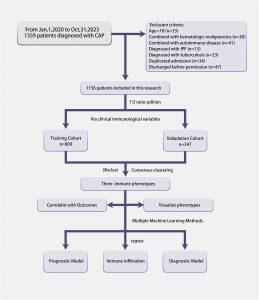Community-acquired pneumonia (CAP) varies widely in clinical presentation and patient outcomes, highlighting the need for improved stratification methods. Traditional clinical scoring systems have limited accuracy for predicting severe cases and mortality. This study leverages machine learning (ML) to analyze immune response profiles in CAP patients, aiming to define immune phenotypes that could improve risk stratification and prognosis.
The researchers conducted a retrospective analysis on 1,156 CAP patients at Xinhua Hospital, Shanghai. Using ML clustering techniques, patients were categorized into three immune phenotypes based on immunological markers, including cytokines and immune cell populations. The study then evaluated the prognostic value of these phenotypes for disease severity and mortality, comparing their predictive accuracy to established CAP scoring systems.
Three distinct immune phenotypes emerged: Phenotype A (mild), Phenotype B (moderate), and Phenotype C (severe). Phenotype C patients showed higher mortality and more severe disease progression, with elevated markers associated with severe inflammation. The best-performing ML model, SuperPC, achieved a high concordance index (C-index) of 0.859 for predicting mortality. In comparison, the random forest model reached an impressive 0.998 C-index for severity prediction in the training cohort, demonstrating a promising advance over traditional models.
Identifying immune phenotypes with ML enhances CAP patient stratification, potentially guiding personalized treatments and improving outcomes. Further validation is necessary, but the approach shows promise as an advanced tool for clinicians.
Summary by Faith Oluwamakinde











